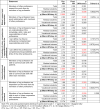A mixed-methods evaluation of interprofessional education in palliative care: changes in student attitudes towards health professions
- PMID: 34651062
- PMCID: PMC8493842
- DOI: 10.3205/zma001500
A mixed-methods evaluation of interprofessional education in palliative care: changes in student attitudes towards health professions
Abstract
Background: Future health care increasingly requires interprofessional thinking and decision-making which should be taught during medical study and vocational training. Against this backdrop, the Medical Faculty at TU Dresden developed an elective course on "Interprofessional Palliative Medicine" in which medical students and trainees in different health professions have been taught together since the 2017 summer semester. An extensive and simultaneous course evaluation conducted in the 2019 summer semester and 2019/20 winter semester investigated if and how strongly attendees' perceptions of interprofessional collaboration had changed as a result of the elective course. Method: The course evaluations included quantitative pre- and post-questions on a questionnaire (n=50) covering, among other things, the perception of roles, according to the Role Perception Questionnaire, and qualitative interviews (n=20). The pre- and post-questions were compared using the Wilcoxon test for related samples and the effect sizes were calculated according to Cohen. The qualitative interviews were analyzed for content using a combined deductive-inductive approach. Results: It was seen that the perceptions and attitudes of each professional group were mutually influenced as a result of the elective course. The quantitative analysis showed the largest effects regarding gains in understanding the roles and competencies of one's own and the other professions (d=0.975) and a reciprocal feeling of "being dependent on each other" (d=0.845). In the interviews, it was seen that medical students developed a greater appreciation for the subject matter and tasks associated with nursing. A strengthening of self-perception was primarily found in the trainees. Conclusion: The elective course on "Interprofessional Palliative Medicine" contributed to the changes in attitude not only with an increased self-awareness of one's own professional group, but also a greater understanding of the roles and expertise of the other health professions. The results speak for the benefit of expanding the interprofessional courses offered.
Hintergrund: Die zukünftige Gesundheitsversorgung erfordert zunehmend interprofessionelles Denken und Handeln, welches bereits im Studium und in der Ausbildung vermittelt werden sollte. Vor diesem Hintergrund entwickelte die Medizinische Fakultät der TU Dresden das Wahlfach „Interprofessionelle Palliativmedizin“, in dem Medizinstudierende sowie Auszubildende verschiedener Gesundheitsfachberufen seit dem Sommersemester 2017 gemeinsam unterrichtet wurden. Eine umfangreiche begleitende Lehrevaluation im Sommersemester 2019 und Wintersemester 2019/2020 ging den Fragen nach, ob - und wie stark - sich durch das Wahlfach Wahrnehmungen der Teilnehmer in Bezug auf interprofessionelle Zusammenarbeit verändert haben.Methodik: Die Lehrevaluation umfasste quantitative Prä- und Post-Befragungen per Fragebögen (n=50), unter anderem zur Rollenwahrnehmung nach dem Role Perception Questionnaire, sowie qualitative Interviews (n=20). Für Vergleiche zwischen der Prä- und Post-Befragung wurden der Wilcoxon Test für verbundene Stichproben durchgeführt sowie die Effektstärken nach Cohen berechnet. Die qualitativen Interviews wurden inhaltsanalytisch mit einen kombiniert deduktiv-induktiven Vorgehen ausgewertet.Ergebnisse: Es zeigte sich, dass durch das Wahlfach die Wahrnehmungen und Einstellungen der jeweiligen Berufsgruppen wechselseitig beeinflusst wurden. Die quantitative Analyse zeigte die größten Effekte bezüglich eines Verständniszuwachses für die Rollen und Kompetenzen der eigenen (und anderer) Berufsgruppen (d=0,975) sowie eines gegenseitigen „Aufeinander-angewiesen-Seins“ (d=0,845). In den Interviews zeigte sich, dass Studierende der Medizin durch das Wahlfach eine höhere Wertschätzung für die Inhalte und Aufgaben der Pflege entwickeln konnten. Bei den Auszubildenden der Gesundheitsfachberufe wurde vor allem eine Stärkung der Selbstwahrnehmung verzeichnet. Schlussfolgerung: Das Wahlfach „Interprofessionelle Palliativmedizin“ trägt zu Veränderung der Wahrnehmung mit besserer Selbstwahrnehmung der eigenen Berufsgruppe sowie größerem Verständnis für Rollen und Kenntnisse anderer Berufsgruppen bei. Die Ergebnisse sprechen für den Nutzen eines Ausbaus interprofessioneller Lehrangebote.
Keywords: health professions; interprofessional education; palliative care; teaching.
Copyright © 2021 Borchers et al.
Conflict of interest statement
The authors declare that they have no competing interests.
Figures



References
-
- Ewers M. Interprofessionalität als Schlüssel zum Erfolg. Public Health Forum. 2012;20(77):10.e1–10.10. doi: 10.1016/j.phf.2012.09.009. - DOI
MeSH terms
LinkOut - more resources
Full Text Sources
Medical

